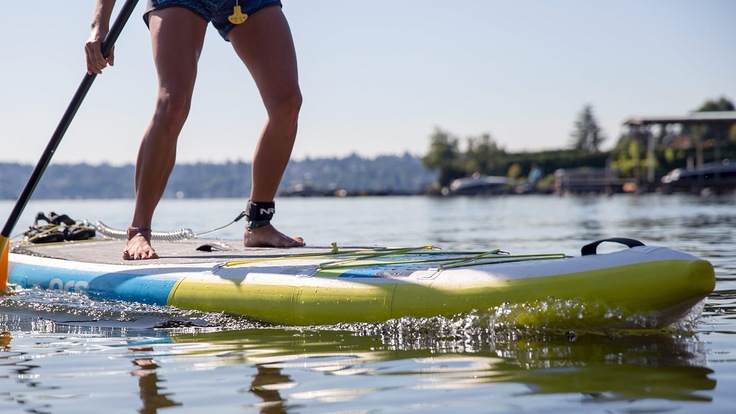A skilled stand up paddle boarder can glide gracefully across the water and maneuver every which way, all while appearing to barely break a sweat. If you're new to SUP, you might be experiencing something entirely different; many beginner paddlers find themselves zigzagging across the lake and quickly growing tired.
With a few tips, you can learn to move the board just as you want and conserve energy while doing so. To set you on your way, here are several key SUP skills, including:
- How to size a SUP paddle
- How to hold a SUP paddle
- Essential SUP strokes
Video: Basic Stand Up Paddle Strokes
How to Size a SUP Paddle
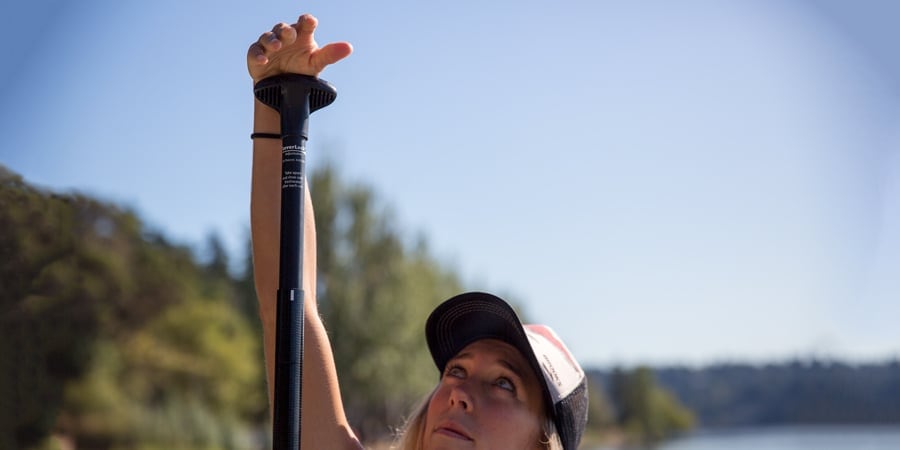
Before you head to the water, you need to be sure you're using the right length paddle. A paddle that's too long is cumbersome to use; one that is too short requires you to awkwardly hunch over to get the paddle into the water.
SUP paddles are available in fixed lengths or adjustable lengths. A fixed-length paddle tends to be lighter and stiffer, making it a good choice for long tours and races. An adjustable paddle lets you experiment with the length while you're learning to SUP, and you can share the paddle with shorter or taller friends and family members. With either fixed- or adjustable-length paddles, make sure it's the right length by doing the following:
- Stand the paddle up vertically so the blade is touching the ground.
- Reach an arm up above your head and notice where it lands on the paddle.
- With a properly sized paddle, the T-grip handle will rest in the bend of your wrist.
Read our article, SUP Paddles: How to Choose, for more information on choosing and sizing a SUP paddle.
How to Hold a SUP Paddle
If there's one sure way to spot a SUP newbie, it's in how they hold the paddle. To help you dodge common errors, here are some tips:
- Blade angle: Hold the blade so it's angled forward from the shaft, not back.
- Hand position: Keep a light grip with one hand on the T-grip and the other on the shaft. Make sure your hands aren't too close together. (Read on for tips on finding the proper position.)
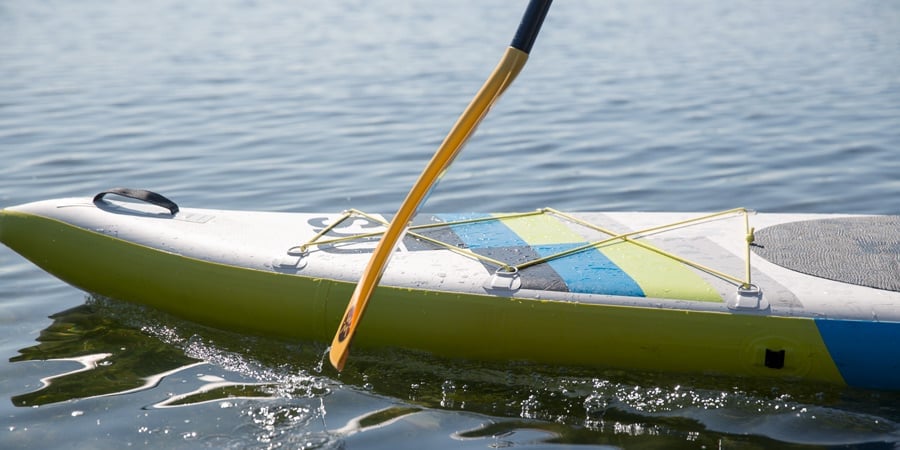
Blade angle: The blade should angle forward slightly from the shaft, toward the nose of the board. You'll almost always use the paddle with the blade oriented this way, unless you're doing one of a handful of specialized strokes. With the paddle blade angled forward, the side of the blade that's aimed back at you is called the power face because it's the side that pushes the water and powers the board forward.
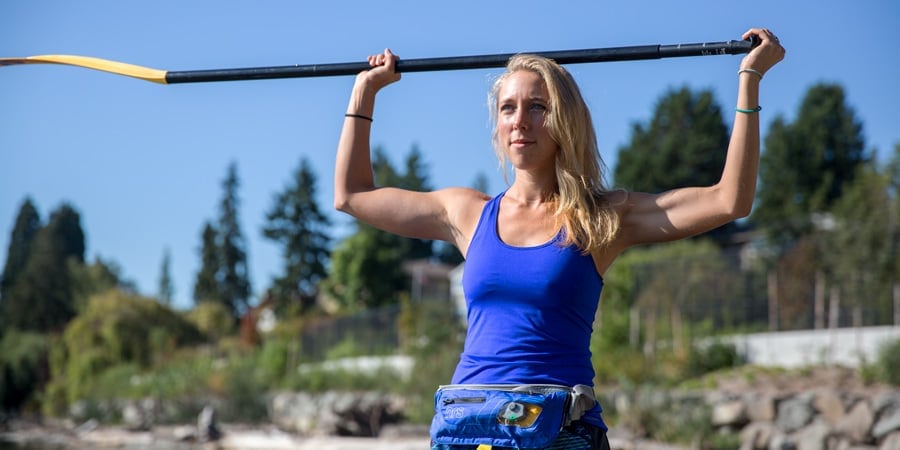
Hand position: Beginners sometimes hold the paddle with their hands too close together, limiting the amount of power they can get out of each stroke. Here's a simple way to figure out where to put your hands:
- Grab the T-grip on the end of the paddle with one hand and the shaft of the paddle with your other hand.
- Raise the paddle above your head so it is in line with your shoulders and rest the shaft on your head.
- While still holding the T-grip with one hand, position your other hand on the shaft so that both arms form 90-degree angles at the elbows. This is where you want your hands positioned on the paddle while paddling.
- It's helpful to mark the spot on the shaft with a piece of colorful tape so you can quickly grab the paddle in the right place.
When you're using the paddle, don't over-grip it. A light grasp on the T-grip and shaft is all you need.
Essential SUP Strokes
At first, you might find it tiresome to paddle or difficult to travel in the direction you want to go, but as you get more comfortable on the water and refine your technique, you'll be able to paddle more efficiently, go straighter and make tighter turns.
Here are five strokes to practice:
Forward stroke
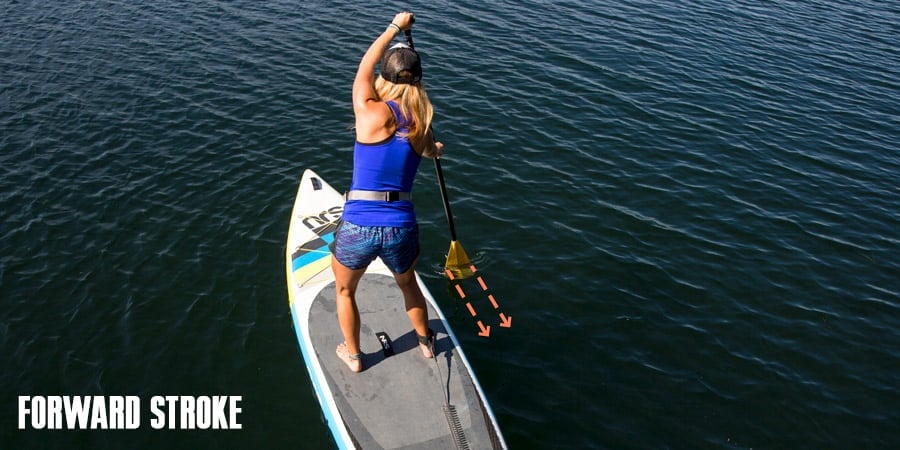
This basic stroke propels your board forward through the water.
- If you're paddling on the right, your right hand is on the paddle shaft and your left hand is on the top of the grip (switch your hands if you're paddling on the left).
- Plant the paddle in the water by reaching as far forward as you reasonably can (about two feet or more) and push the blade all the way under the surface, then bring it back to your ankle, then out of the water.
- Keep your arms nearly straight and twist from your torso as you paddle. Push down on the paddle grip with your top hand rather than pulling the paddle back with your lower arm.
Tips:
- Imagine your body and paddle forming the shape of an A, where your body is one side of the A, your upper arm and paddle shaft make up the other side, and your lower arm is the bar connecting the two sides.
- Think about pulling the board past the paddle rather than pulling the paddle through the water.
- To travel straight, you'll need to alternate which side of the board you paddle on. There's no set number of strokes per side; try about three or four strokes on one side, then switch to the other. When you switch sides, you reverse hand positions.
- The more vertical you keep the paddle, the straighter you will go.
Reverse stroke
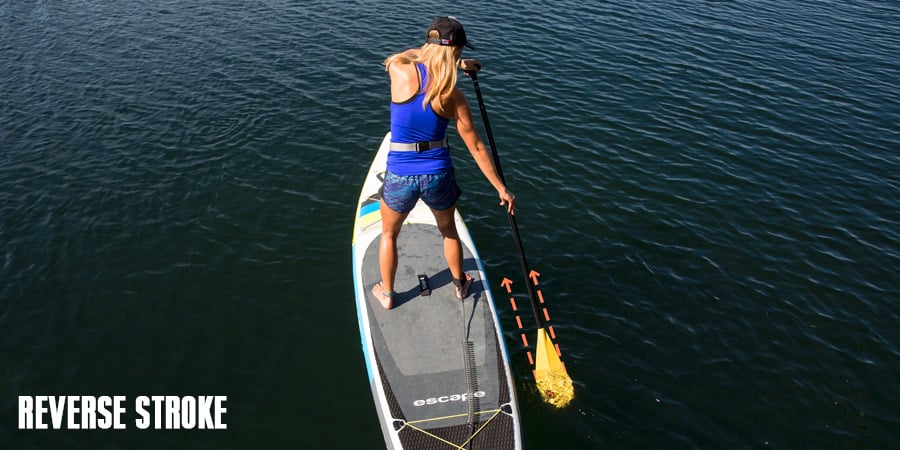
The reverse stroke is simple to perform and can be used for slowing down, stopping and turning. It is essentially the opposite of the forward stroke.
- If you're paddling on the right, reach back behind you and plant the paddle in the water near the tail of your board. Make sure the blade is all the way under the surface of the water.
- Like with the forward stroke, keep your arms straight and twist from your torso rather than pulling the blade forward with your arms.
- Doing the reverse stroke on the right side of your board will cause the nose of your board to turn to the right and vice versa.
Sweep stroke
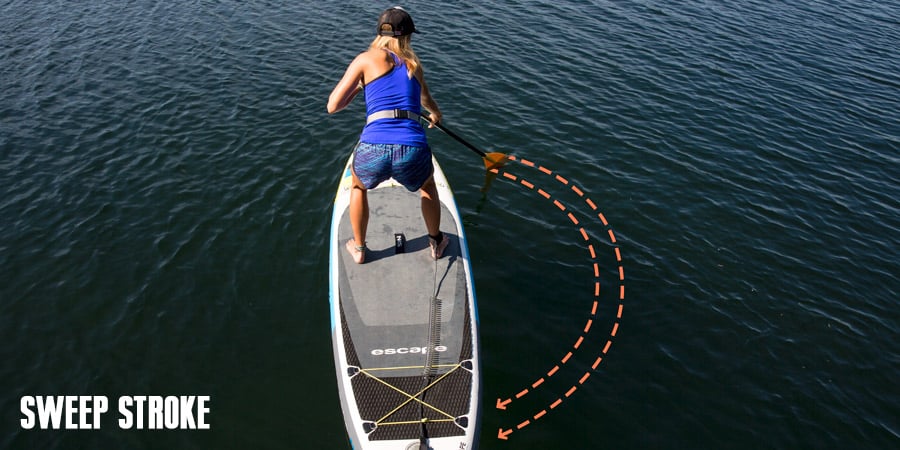
The sweep stroke is useful for turning your board while standing still or moving.
- Bend your knees slightly more than you would for the forward stroke and lower your arms a bit so the T-grip on the paddle is just below shoulder height.
- If you're paddling on the right, rotate your shoulders so that your right shoulder comes forward.
- Reach forward and plant your paddle in the water, submerging the entire blade so it's perpendicular to your board.
- Sweep the paddle away from the board in a big arcing motion from the nose of the board to the tail by rotating your torso and using the leverage of your legs and hips.
- Doing the sweep stroke on the right side of your board will turn the board to the left (and vice versa on the other side).
Tips:
- You can do the sweep stroke in reverse to turn yourself in the opposite direction of the standard sweep. Then do the reverse sweep, plant the paddle blade in the water by the tail of your board and bring it forward in an arc toward the nose.
- An advanced technique that will turn the board more abruptly involves stepping back on your board in a surf stance to unweight the nose of the board and then doing the sweep stroke.
Draw Stroke
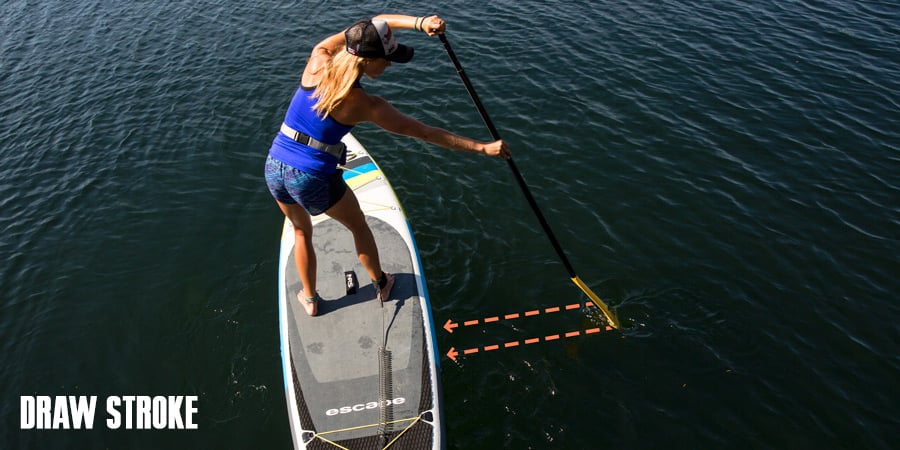
The draw stroke moves your boat to the side and is useful when you're trying pull up alongside a dock or make a maneuver to change your course. Here's how you do the basic draw stroke:
- Rotate your shoulders toward whichever direction you want to move and reach over the side of your board to plant the paddle in the water.
- Plant the paddle with the blade parallel to the board and the power face toward the board.
- Pull the blade toward you to move the board in the direction of the paddle.
- Slice the blade out of the water by swinging it toward the nose or tail of the board and repeat the stroke.
Tip:
- The fins on the tail of your board resist lateral movement, which can cause the tail to move more slowly than the nose. To counter this, you may need to place your paddle in the water closer to the tail than the nose.
Cross Bow Stroke
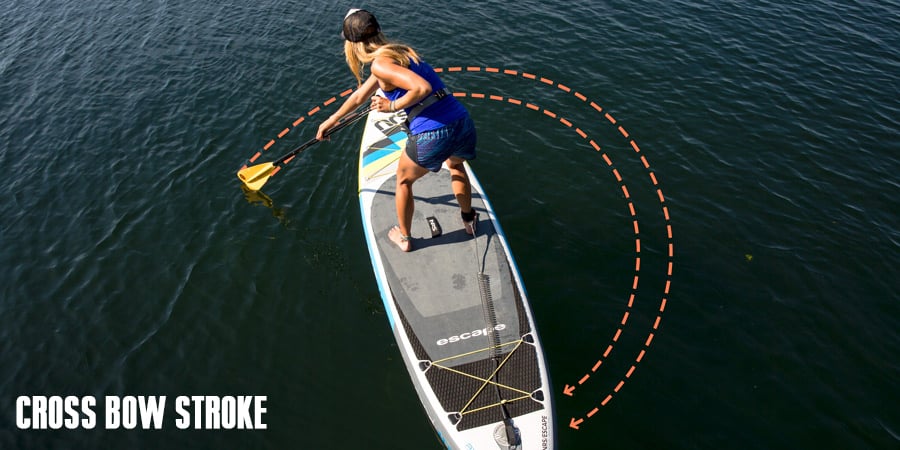
The cross bow stroke delivers a tight, efficient turn without having to change your stance on the board. It's great for making quick course adjustments while moving. Here's how to do a cross bow stroke to turn to the left:
- While paddling on the right side and standing in your normal neutral stance in the center of your board, rotate your torso to the left so your right shoulder is forward.
- Bring the paddle across the nose of your board and place the blade fully in the water on the left side of your board.
- With the power face of the blade facing to the right, rotate your torso to the right to bring the paddle toward the nose of your board.
- If you can clear the nose of your board with the paddle blade, then continue to bring the paddle around. If your blade is going to bump into your board, lift it out of the water then put it back in on the other side and continue bringing the paddle around the board in an arcing motion.
- To turn to the right, start with your paddle on the left side and reach across to the right.
